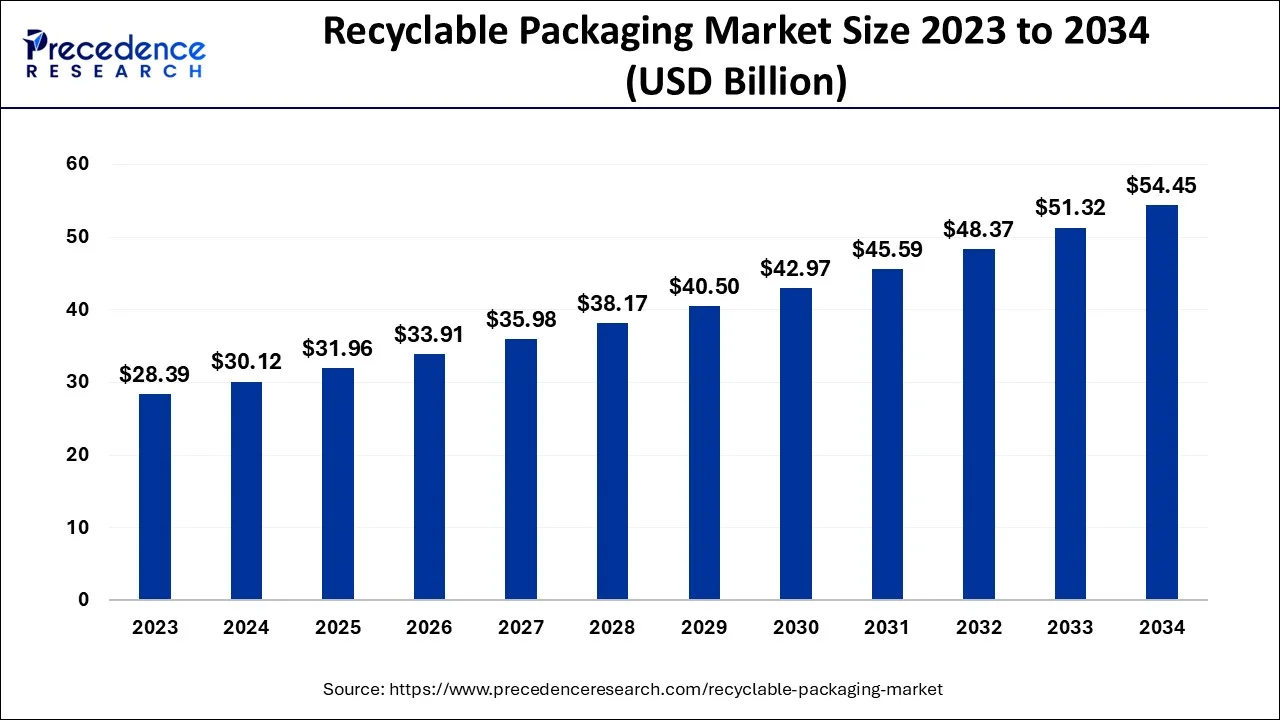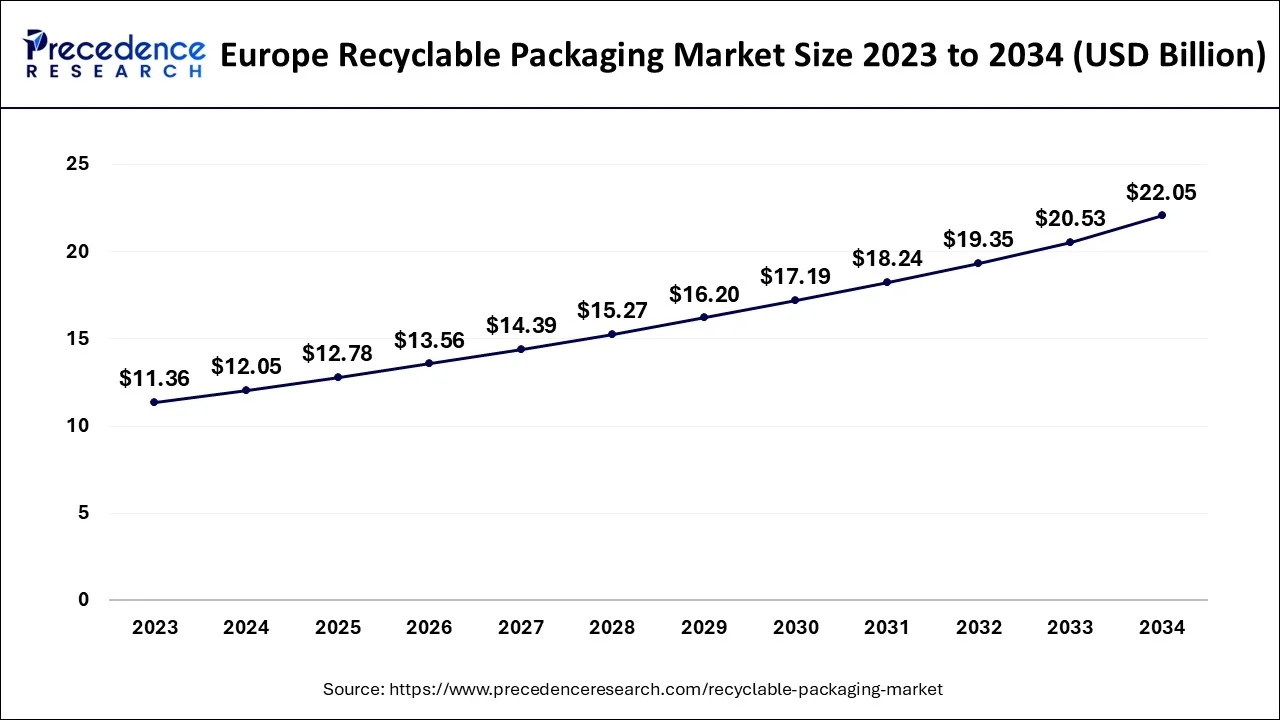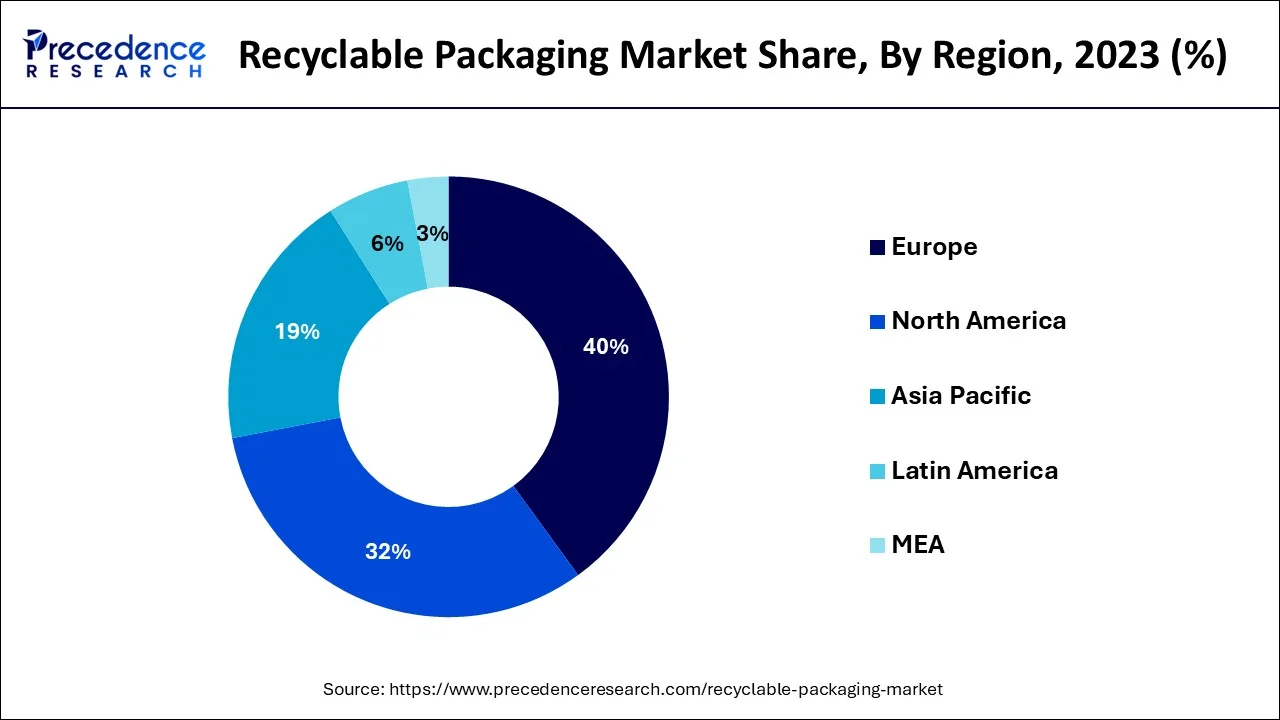January 2025
The global recyclable packaging market size accounted for USD 30.12 billion in 2024, grew to USD 31.96 billion in 2025 and is predicted to surpass around USD 54.45 billion by 2034, representing a healthy CAGR of 6.10% between 2024 and 2034.
The global recyclable packaging market size is accounted for USD 30.12 billion in 2024 and is anticipated to reach around USD 54.45 billion by 2034, growing at a CAGR of 6.10% from 2024 to 2034.

The Europe recyclable packaging market size is evaluated at USD 12.05 billion in 2024 and is predicted to be worth around USD 22.05 billion by 2034, rising at a CAGR of 6.21% from 2024 to 2034.

With the highest revenue share across regional markets, Europe became the biggest market for accounting and budgeting software in 2023. The region's adoption of stricter goals, such as the requirement for only recyclable packaging and fines for introducing non-recyclable packaging, is largely responsible for the region's revenue growth. Additionally, many businesses are going above and beyond the European Union's already strict recycling standards with Extended Producer Responsibilities, especially in nations like France, Germany, and the United Kingdom (EPRs). Due to the presence of key industry players in the area, such as Amcor, DS Smith, Mondi, and Tetra Laval, the recyclable packaging market in Europe is anticipated to experience strong revenue growth throughout the course of the projection period.

Over the projected period, the market for recyclable packaging in Asia-Pacific is anticipated to develop at the quickest CAGR. The main drivers fueling the growth of the APAC market are rising consumer awareness of recyclable packaging and the popularity of eCommerce. The region's countries, like China and Indonesia, have statewide bans on single-use plastics, which has helped the APAC industry expand.
Recyclable packaging is used to enclose or protect products for storage, distribution, and sale, and is utilized with recyclable resources like glass, corrugated cardboard, corrugated cardboard, card, metal, paper, and others. Recyclable packaging materials offer several benefits, including the preservation of natural resources, the reduction of manufacturing energy, and the decrease in greenhouse gas emissions, all of which contribute to lowering the carbon footprint. Recyclable packaging makes trash management simpler because it may be recycled, reused, or biodegraded.
The phrase "recyclable packaging" refers to items sold in recyclable packaging by businesses, individuals, and partnerships. These items are used to enclose or protect goods made of recyclable materials such as glass, card, metal, corrugated cardboard, paper, and others for distribution, storage, sale, and usage. The preservation of natural resources, the reduction of manufacturing energy, and the decrease of greenhouse gas emissions are just a few advantages of recyclable packaging materials, all of which help reduce the carbon footprint. Because recyclable packaging may be recycled, reused, or biodegraded, waste management is made easier. Therefore, it is anticipated that throughout the projection period, demand for recyclable packaging would increase as recycling regulations become more stringent.
The market for recyclable packaging has seen the emergence of eco-friendly packaging as a major trend. Biodegradable, reusable, recyclable, non-toxic, and made from recycled materials are all characteristics of eco-friendly packaging. Utilizing eco-friendly packaging reduces carbon footprint, encourages green living, aids in energy conservation, and also guards against noise, water, and air pollution. For instance, the American multinational consumer products business P&G (Procter & Gamble) began choosing eco-friendly packaging in April 2020. For their deodorant products, companies like Old Spice and Secret Sporting have introduced new environmentally friendly packaging.
Although recyclable packaging is utilized in almost every industry, it is most frequently observed in the food and beverage, wholesale, FMCG, healthcare, retail, and other sectors, to name a few. This brand-new packaging idea has also created new opportunities for creativity, enabling business owners to venture into unexplored terrain.
Eco-friendly packaging has emerged as a key trend in the recyclable packaging market. Eco-friendly packaging is biodegradable, recyclable, reusable, non-toxic, and constructed from recycled items. The use of eco-friendly packaging decreases carbon footprint and promotes green living which helps to conserve energy and also prevents air, water, and noise pollution. For instance, in April 2020, P&G (Procter & Gamble), an American multinational consumer goods corporation, started opting for eco-friendly packaging. Brands such as Old Spice and Secret Sporting started new eco-friendly packaging for their deodorant products.
| Report Coverage | Details |
| Market Size in 2024 | USD 30.12 Billion |
| Market Size by 2034 | USD 54.45 Billion |
| Growth Rate from 2024 to 2034 | CAGR of 6.10% |
| Largest Market | Europe |
| Fastest Growing Market | Asia Pacific |
| Base Year | 2023 |
| Forecast Period | 2024 to 2034 |
| Segments Covered |
|
| Regions Covered |
|
Growth in FMCG sector and rise in household recycling
Growing environmental concern and demand for eco-friendly packaging
Rising efficiency in e-commerce
Increasing knowledge about the importance of recyclable packaging
Over the projected period, the paper sector is anticipated to account for the biggest revenue share by packaging material type. Due to well-established recycling streams and procedures, paper-based packaging has the greatest recycling rate of any form of packaging. Before the fibers are too weak to be reused, paper trash can be recycled seven times. Paper packaging provides customers with practical storage that is attractive, simple to use, and particularly ecologically friendly, which are significant reasons fostering this market's expansion.
The beverages section is anticipated to outperform the other categories in terms of revenue share throughout the projection period, according to the end-user industry. Water to alcohol is only a few of the many beverages available, all of which need packaging to be served to customers. Beverages come in a variety of recyclable packaging forms, including glass, aluminum cans, recyclable plastic bottles, and new paper-based water boxes, all of which can help this sector's revenue development.
By Packaging Material Type
By Type of Packaging
By End-User Industry
By Geography
For inquiries regarding discounts, bulk purchases, or customization requests, please contact us at sales@precedenceresearch.com
No cookie-cutter, only authentic analysis – take the 1st step to become a Precedence Research client
January 2025
January 2025
January 2025
March 2025